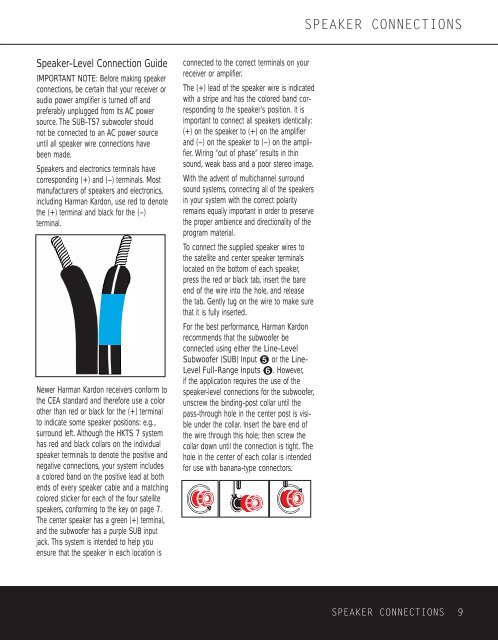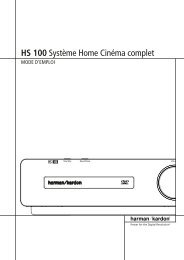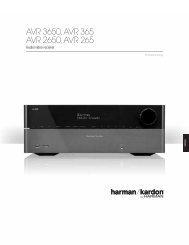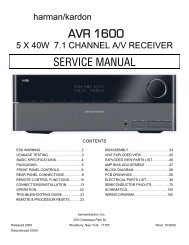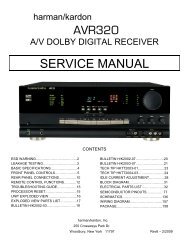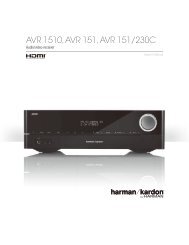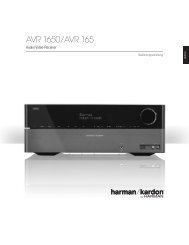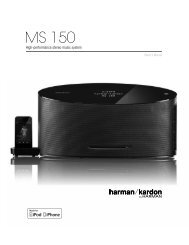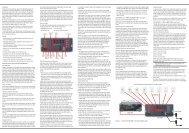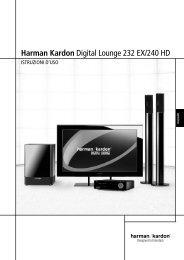HKTS 7 OM - Harman Kardon
HKTS 7 OM - Harman Kardon
HKTS 7 OM - Harman Kardon
You also want an ePaper? Increase the reach of your titles
YUMPU automatically turns print PDFs into web optimized ePapers that Google loves.
SPEAKER CONNECTIONS<br />
Speaker-Level Connection Guide<br />
IMPORTANT NOTE: Before making speaker<br />
connections, be certain that your receiver or<br />
audio power amplifier is turned off and<br />
preferably unplugged from its AC power<br />
source. The SUB-TS7 subwoofer should<br />
not be connected to an AC power source<br />
until all speaker wire connections have<br />
been made.<br />
Speakers and electronics terminals have<br />
corresponding (+) and (–) terminals. Most<br />
manufacturers of speakers and electronics,<br />
including <strong>Harman</strong> <strong>Kardon</strong>, use red to denote<br />
the (+) terminal and black for the (–)<br />
terminal.<br />
Newer <strong>Harman</strong> <strong>Kardon</strong> receivers conform to<br />
the CEA standard and therefore use a color<br />
other than red or black for the (+) terminal<br />
to indicate some speaker positions: e.g.,<br />
surround left. Although the <strong>HKTS</strong> 7 system<br />
has red and black collars on the individual<br />
speaker terminals to denote the positive and<br />
negative connections, your system includes<br />
a colored band on the positive lead at both<br />
ends of every speaker cable and a matching<br />
colored sticker for each of the four satellite<br />
speakers, conforming to the key on page 7.<br />
The center speaker has a green (+) terminal,<br />
and the subwoofer has a purple SUB input<br />
jack. This system is intended to help you<br />
ensure that the speaker in each location is<br />
connected to the correct terminals on your<br />
receiver or amplifier.<br />
The (+) lead of the speaker wire is indicated<br />
with a stripe and has the colored band corresponding<br />
to the speaker’s position. It is<br />
important to connect all speakers identically:<br />
(+) on the speaker to (+) on the amplifier<br />
and (–) on the speaker to (–) on the amplifier.<br />
Wiring “out of phase” results in thin<br />
sound, weak bass and a poor stereo image.<br />
With the advent of multichannel surround<br />
sound systems, connecting all of the speakers<br />
in your system with the correct polarity<br />
remains equally important in order to preserve<br />
the proper ambience and directionality of the<br />
program material.<br />
To connect the supplied speaker wires to<br />
the satellite and center speaker terminals<br />
located on the bottom of each speaker,<br />
press the red or black tab, insert the bare<br />
end of the wire into the hole, and release<br />
the tab. Gently tug on the wire to make sure<br />
that it is fully inserted.<br />
For the best performance, <strong>Harman</strong> <strong>Kardon</strong><br />
recommends that the subwoofer be<br />
connected using either the Line-Level<br />
Subwoofer (SUB) Input ∞ or the Line-<br />
Level Full-Range Inputs §. However,<br />
if the application requires the use of the<br />
speaker-level connections for the subwoofer,<br />
unscrew the binding-post collar until the<br />
pass-through hole in the center post is visible<br />
under the collar. Insert the bare end of<br />
the wire through this hole; then screw the<br />
collar down until the connection is tight. The<br />
hole in the center of each collar is intended<br />
for use with banana-type connectors.<br />
SPEAKER CONNECTIONS 9


